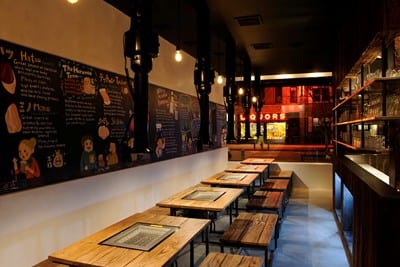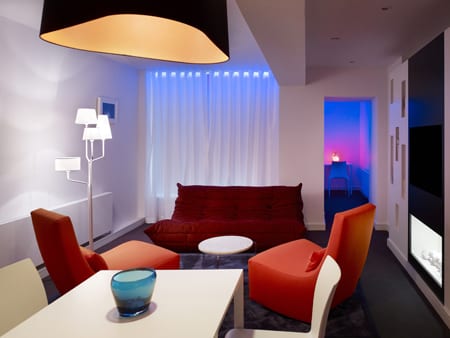At Takashi in New York’s West Village, diners sit huddled around eco-friendly grills-they replicate a flame emitted by charcoal versions-cooking premium cuts of meat underneath telescopic vents imported from Japan. This culinary ritual, yakinuku, not only encourages playing with your food, but inspires interactive design. For example, to enlighten guests about different cuts of meat, a chalkboard doubles as a primer and a canvas for whimsical cartoons.

Takashi’s owners, chef Takashi Inoue and Saheem Ali, who were actively involved in crafting the look of the restaurant, turned to NYC-based James Conran Design to marry Japanese elegance that references Takashi’s native Osaka with the neighborhood’s casual vibe.
“We wanted the look and feel of a warm industrial space, to keep a clean aesthetic balanced with presenting surfaces and patinas that showed the age of time. I think the mix of materials is superb. From the wood used to make the tables to the cold feel of the plaster, Takashi is a visual and tactile delight,” Conran notes.
For the showpiece walls, Conran coated them with two rough layers of course grain marmorino plaster mixed with metallic mica chips. “The rough-on-rough process actually produces a smooth wall as the ‘valleys’ of the first layer are filled with the ‘hills’ of the second. The end result is walls that look and feel like heavy slabs of stone,” Conran explains. Other surfaces, he points out, were treated as aged steel with metallic paints and antique glazes.

The restaurant’s most intriguing element might be those unique vents, outfitted with spotlights. “In Asian-style barbeque restaurants these tend to be bulky. We knew we wanted something sleek to match the visual style of the space, and so we were careful to select something that functioned well and looked good at the same time,” notes Ali.
With so much of the restaurant a cutting-edge nod to Japan, Ali says he and Takashi felt it was essential to incorporate a local element “with a sense of age and history.” After visiting a number of reclaimed lumber farms upstate, the duo stumbled upon mushroom wood with a “beautifully unpredictable” surface that translated well to tabletops. “We were also fascinated by its history, originally being cypress wood used as bins for mushroom harvesting,” Ali points out. “The fact that its primary purpose was the creation of food felt ideal for its second life in our restaurant.”


